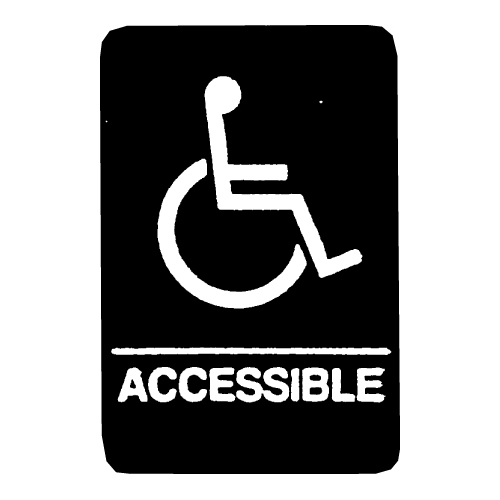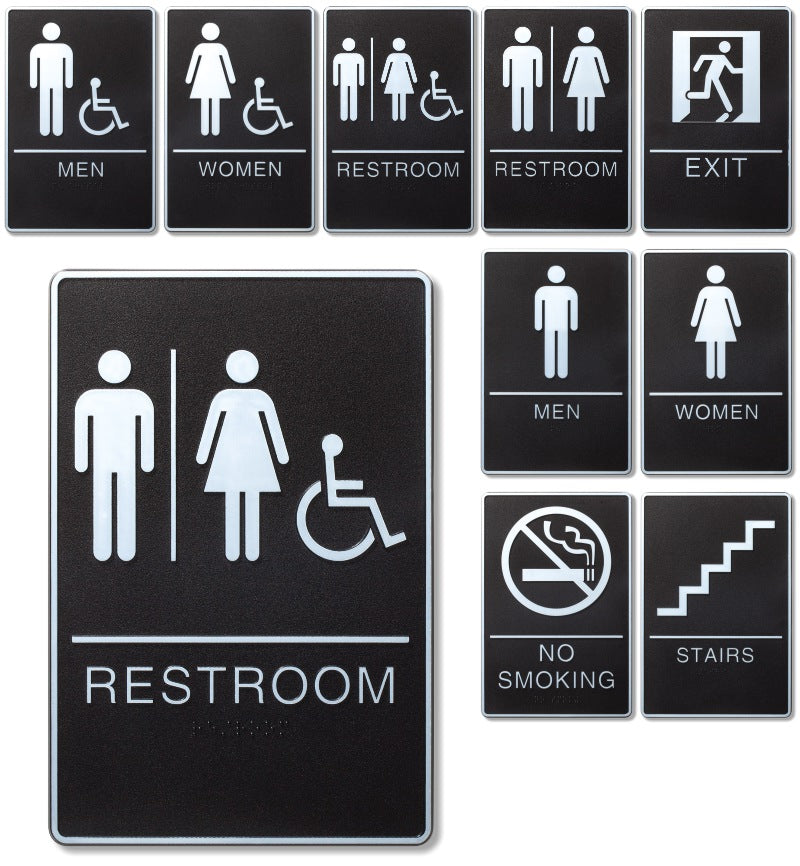ADA Signs: Vital Devices for Inclusive Atmospheres
ADA Signs: Vital Devices for Inclusive Atmospheres
Blog Article
ADA Signage: Making Sure Ease Of Access and Compliance in Public Spaces
ADA signage plays an important function in assuring accessibility and conformity within public spaces, substantially adding to an inclusive environment for individuals with handicaps. As we explore the nuances of ADA signage, from tactile attributes to design details, it's crucial to take into consideration just how these components coalesce to copyright the legal rights of all customers.
Importance of ADA Signs
In contemporary society, the significance of ADA signage extends beyond mere conformity with lawful requireds to embody a commitment to inclusivity and access for all people. These signs are essential in developing environments where individuals with impairments can navigate public rooms with the exact same simplicity and self-reliance as those without impairments. By providing standard and clear details, ADA signage makes certain that everyone can access facilities, solutions, and details without barriers.
The significance of ADA signs depends on its ability to boost the high quality of life for individuals with specials needs by advertising equivalent access. It eliminates the obstacles that could or else hinder their ability to participate totally in community life. These indicators offer as noticeable indicators of a company's dedication to diversity and equal rights, showing broader social worths that champion the legal rights and dignity of all people.
Furthermore, ADA signage plays a crucial role in public security. By directing people to departures, washrooms, and other important facilities, it makes certain that all people, no matter of physical ability, can leave safely throughout emergencies. In summary, ADA signage is not just a governing requirement however a powerful tool for cultivating a fair and comprehensive society.
Trick Components of Conformity

Placement is crucial; indicators need to be mounted in areas that are quickly visible and obtainable. Generally, signs must be installed in between 48 and 60 inches from the ground to make certain ease of access for both standing and mobility device individuals. Tactile aspects, such as Braille, are necessary for people with visual problems, supplying essential info in a non-visual format.
High-contrast shades in between the text and background are necessary to improve readability for people with reduced vision. The ADA mandates details comparison proportions to guarantee clarity. Furthermore, character dimension is an essential consideration, with minimal elevation needs dictated by the seeing range to ensure readability from various angles.
Style Factors To Consider for Access
Designing obtainable signs needs a careful approach to guarantee it meets the requirements of all customers, specifically those with impairments. The dimension of the message is just as vital, with ADA standards suggesting a minimal height based on checking out distance to ensure readability.
Contrasting shades between message and background are necessary for visibility, specifically for people with visual disabilities. Furthermore, responsive components, such as Braille and increased characters, are essential for individuals that are blind or have low vision.
Additionally, the positioning of signs plays a considerable duty in access. Indications must be discover this info here set up in places that are unblocked and quickly reachable. Ensuring that signage is installed at appropriate heights and angles enables all customers, consisting of those using mobility devices, to connect with them successfully.
Typical Errors to Stay Clear Of

An additional prevalent mistake is the incorrect placement of signs. ADA guidelines define accurate height and location needs to make sure that signs are easily visible and reachable by all people, consisting of those utilizing mobility devices. Overlooking these standards not only obstructs access however additionally runs the risk of non-compliance with legal requirements.
Furthermore, inadequate comparison in between text and background is a constant oversight. Ample comparison is necessary for readability, specifically for people with reduced vision. Developers occasionally choose colors that are visually attractive but do not have the necessary comparison, providing the text difficult to determine.
Finally, some designers stop working to include tactile aspects, such as Braille, which are crucial for individuals who are blind. Omitting these attributes not just results in non-compliance with ADA regulations however also limits gain access to for a segment of the population that depends on responsive details.
Future Trends in Signs
Innovations in modern technology and enhancing understanding of inclusivity are shaping the future trends in signage design. As culture comes to be much more aware of varied needs, the assimilation of clever modern technologies into signs is gaining traction. Digital signs, as an example, is evolving to consist of real-time updates and interactive functions, which can be essential in important site supplying vibrant details in public rooms. These indicators often include touch displays or gesture-based controls, allowing customers to navigate material customized to their particular needs.
One more arising pattern is the usage of augmented fact (AR) to improve user experience. AR-enabled signage can overlay digital info onto the physical setting, giving aesthetically impaired individuals with auditory or haptic feedback. ADA Signs. This innovation not just enhances access yet likewise creates an appealing experience for all users
Sustainability is additionally a considerable aspect affecting signs fads. Green products and energy-efficient lights options are being prioritized to align with worldwide environmental goals. Furthermore, innovations in products scientific research are resulting in the development of more weather-resistant and resilient indicators.
Conclusion
ADA signage plays a crucial duty in ensuring ease of access and compliance within public spaces by incorporating tactile elements, high-contrast shades, and calculated placement. The adherence to ADA standards not just promotes risk-free navigating for individuals with specials needs yet also indicates an organization's devotion to diversity and inclusivity. By staying clear of common mistakes and accepting future fads, public areas can remain to advance these worths, guaranteeing that the legal rights and self-respect of all individuals are appreciated and promoted.
ADA signs plays a crucial role in assuring accessibility and conformity within view it public areas, considerably adding to an inclusive environment for people with disabilities. As we discover the nuances of ADA signage, from responsive functions to develop intricacies, it's critical to take into consideration how these elements integrate to maintain the rights of all users.In modern society, the value of ADA signage extends beyond plain compliance with lawful mandates to symbolize a commitment to inclusivity and access for all individuals. By giving clear and standard details, ADA signage makes sure that everybody can access facilities, services, and information without barriers.
ADA signs plays an essential role in guaranteeing availability and conformity within public spaces by incorporating responsive components, high-contrast colors, and tactical placement. (ADA Signs)
Report this page